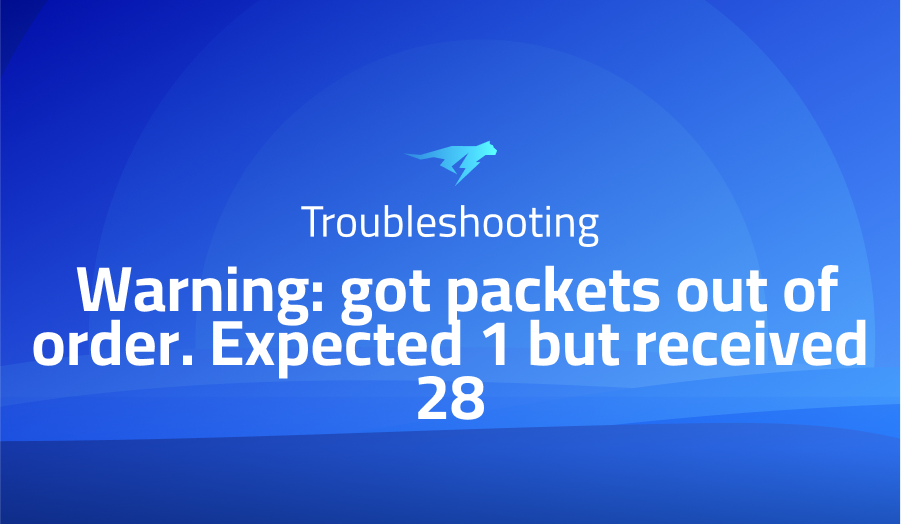

Warning: got packets out of order. Expected 1 but received 28
Explanation of the problem
When attempting to create a MySQL server using the node-mysql2 library, I encountered a series of errors that indicate out-of-order packets being received. Specifically, I received the following warnings: “got packets out of order. Expected X but received Y”. Along with these warnings, the output contained an array of data with row and column information.
Troubleshooting with the Lightrun Developer Observability Platform
Getting a sense of what’s actually happening inside a live application is a frustrating experience, one that relies mostly on querying and observing whatever logs were written during development.
Lightrun is a Developer Observability Platform, allowing developers to add telemetry to live applications in real-time, on-demand, and right from the IDE.
- Instantly add logs to, set metrics in, and take snapshots of live applications
- Insights delivered straight to your IDE or CLI
- Works where you do: dev, QA, staging, CI/CD, and production
Start for free today
Solution: Warning: got packets out of order. Expected 1 but received 28
The server initialization code responsible for establishing the connection is shown below. The serverHandshake function is called with an object containing several parameters that define the connection, including the protocol version, server version, and character set. The connectionId variable is incremented to ensure that each connection has a unique ID.
connection.serverHandshake({
capabilityFlags: 0xffffff,
characterSet: 8,
connectionId: connectionId++,
protocolVersion: 10,
serverVersion: '5.6.10',
statusFlags: 2
});Despite providing the necessary connection parameters, the out-of-order packet warnings suggest that there may be an issue with the connection or with the server itself. It is also worth noting that the code is using Node.js v7.7.1, which is a relatively old version of Node.js that may not be fully compatible with the node-mysql2 library or the MySQL server being used.
Other popular problems with Gajus
Gajus is a popular Github repository that provides a set of tools for working with databases in Node.js. Here are three common problems associated with Gajus and their solutions:
- Unexpected behavior with connection pooling: One common issue when working with Gajus is unexpected behavior with connection pooling. This can occur when the connection pool size is not properly configured or when there are issues with connection acquisition and release. Here is an example of how to properly configure the connection pool size using the
mysql2library:
const mysql = require('mysql2/promise');
const pool = mysql.createPool({
host: 'localhost',
user: 'user',
password: 'password',
database: 'database',
waitForConnections: true,
connectionLimit: 10,
queueLimit: 0
});
In this example, the connectionLimit parameter sets the maximum number of connections in the pool. By setting it to 10, we ensure that the pool has enough resources to handle the expected load.
- Performance issues with large result sets: Another common issue with Gajus is performance degradation when working with large result sets. This can occur when the database returns more data than is necessary or when the query is not properly optimized. One way to improve performance is to use pagination to limit the amount of data returned by the query. Here is an example of how to implement pagination using Gajus:
const pageSize = 10;
const pageNumber = 1;
const offset = (pageNumber - 1) * pageSize;
const result = await connection.query(`SELECT * FROM table LIMIT ${pageSize} OFFSET ${offset}`);In this example, we limit the result set to 10 records and offset the results based on the page number. By doing this, we ensure that only the necessary data is returned and that the query runs efficiently.
- Connection errors and timeouts: Finally, connection errors and timeouts can also be a problem when using Gajus. These issues can occur when there are issues with the network or when the database is overloaded. One way to handle these errors is to implement error handling and retry mechanisms in the code. Here is an example of how to implement retry logic using the
retrylibrary:
const retry = require('retry');
const operation = retry.operation({
retries: 3,
factor: 3,
minTimeout: 1 * 1000,
maxTimeout: 60 * 1000,
randomize: true,
});
operation.attempt(async function() {
try {
const result = await connection.query('SELECT * FROM table');
} catch (err) {
if (err.code === 'PROTOCOL_CONNECTION_LOST') {
operation.retry(err);
} else {
console.error(err);
}
}
});
In this example, we use the retry library to attempt the database connection up to 3 times with increasing timeouts. If the connection fails, the code will retry the operation up to 3 times. By doing this, we ensure that the code can handle network issues and other connection errors.
A brief introduction to Gajus
Gajus is a prominent software developer known for his contributions to various open-source projects, particularly in the field of web development. He is the creator of several popular JavaScript libraries, such as react-final-form, reciprocity, and Buddy.js, which have been used by thousands of developers worldwide. In addition, Gajus is a prolific blogger and conference speaker, sharing his expertise and insights on various topics related to software development, including JavaScript, web performance, and best practices.
Gajus is also well-known for his contributions to the wider developer community, including organizing and speaking at meetups and conferences, contributing to open-source projects, and providing mentorship and guidance to aspiring developers. He is an advocate for open-source software and believes in the power of community-driven development, promoting transparency, collaboration, and inclusivity in all of his work. His dedication to the field of web development has earned him a strong reputation and a loyal following among developers worldwide.
Most popular use cases for Gajus
- React-final-form: Gajus’s library, React-final-form, is a popular solution for form management in React applications. It provides a simple, intuitive API for building and managing complex forms, allowing developers to streamline the form-building process and focus on creating rich, dynamic user interfaces. Here is an example of how React-final-form can be used to create a basic login form:
import React from 'react';
import { Form, Field } from 'react-final-form';
const Login = () => {
const onSubmit = (values) => {
// handle form submission
};
const validate = (values) => {
// validate form values
};
return (
<Form onSubmit={onSubmit} validate={validate}>
{({ handleSubmit, submitting }) => (
<form onSubmit={handleSubmit}>
<div>
<label htmlFor="username">Username</label>
<Field name="username" component="input" type="text" />
</div>
<div>
<label htmlFor="password">Password</label>
<Field name="password" component="input" type="password" />
</div>
<button type="submit" disabled={submitting}>
Submit
</button>
</form>
)}
</Form>
);
};
export default Login;
- Buddy.js: Another popular library created by Gajus is Buddy.js, a tool for enforcing coding standards and best practices in JavaScript codebases. Buddy.js provides a set of configurable rules for enforcing standards related to syntax, performance, security, and more, helping developers ensure that their code is clean, efficient, and secure. Buddy.js can be integrated into the development process using tools like Webpack or Gulp, and can be configured to run automatically as part of a CI/CD pipeline.
- Contributions to open-source: Beyond his specific libraries and tools, Gajus is known for his contributions to the wider developer community through his work on open-source projects. He has contributed to a wide range of projects, including popular libraries like Babel and React, and has provided mentorship and guidance to developers through his blog, conference talks, and other outreach efforts. Gajus’s work in the open-source community has helped advance the field of web development and has enabled countless developers to build better, more reliable software.
It’s Really not that Complicated.
You can actually understand what’s going on inside your live applications.




